Meeting of the HB
Civil Defence Emergency Management Group
Joint Committee
Date: 25 November 2024
Time: 2.00pm
|
Venue:
|
Council
Chamber
Hawke's
Bay Regional Council
159
Dalton Street
NAPIER
|
Agenda
Item Title Page
1. Welcome/Karakia/Housekeeping/Apologies
2. Conflict
of Interest Declaration
3. Confirmation
of Minutes of the HB Civil Defence Emergency Management Group Joint Committee
held on 29 July 2024
4. Deputation:
Kate Taylor, Chair of HB FENZ Local Advisory Committees
Decision
Items
5. Local
Controllers' delegated powers 3
Information
or Performance Monitoring
6. HB
CDEM Group Manager / Group Controller update 7
7. HB
Regional Recovery Agency update 45
8. HB
CDEM Group Transformation update 53
Public
Excluded Decision Items
9. Confirmation
of Public Excluded Minutes 57
10. Local
Controller Appointments 59
HB
CDEM Group Joint Committee
25
November 2024
Subject:
Local Controllers' delegated powers
Reason for report
1. This item informs the HB
CDEM Group Joint Committee of the delegation of Emergency Powers to Local
Controllers, addressing gaps identified in the current Group Plan, and
recommending the delegation of Emergency Powers in sections 86 and 87 of the
CDEM Act to ensure operational effectiveness during emergencies.
2. As a result, minor
amendments will be made to the Hawke’s Bay CDEM Group Plan to reflect
these changes.
Discussion
3. Local Controllers are
appointed and delegated Emergency Powers under Section 27(1) of the Civil
Defence Emergency Management Act.
4. These Emergency Powers may
include those outlined in Sections 86 to 92 of the Act.
5. The Hawke’s Bay CDEM
Group Plan 2014–2019 specifies Local Controller appointments and the
powers delegated to them.
6. The Group Plan lists the
Emergency Powers in Sections 88 to 92 are delegated to Local Controllers.
7. Local Controllers have not
been delegated the following powers:
86 Evacuation of premises
and places
If a state of emergency is
in force and, in the opinion of a Controller or any constable, the action
authorised by this section is necessary for the preservation of human life,
that person or a person authorised by him or her may direct, within the
area or district in which the emergency is in force,—
(a) the
evacuation of any premises or place, including any public place; or
(b) the
exclusion of persons or vehicles from any premises or place, including any
public place.
87 Entry on premises
If a state of emergency is
in force in any area, a Controller or a constable, or any person acting
under the authority of a Controller or constable, may enter on, and if
necessary break into, any premises or place within the area or district in
respect of which the state of emergency is in force if he or she believes on
reasonable grounds that the action is necessary for—
(a) saving
life, preventing injury, or rescuing and removing injured or endangered
persons; or
(b) permitting
or facilitating the carrying out of any urgent measure for the relief of
suffering or distress.
8. These powers can be
exercised by any sworn member of the New Zealand Police within areas covered by
a state of emergency.
9. The lack of delegated
Emergency Powers under Sections 86 and 87 for Local Controllers may be due to
an oversight or an error in the CDEM Group Plan.
10. To ensure clarity and
effectiveness, It is recommended that all current and future Local Controllers
be delegated Emergency Powers in Section 86 (Evacuation of premises and places)
and 87 (Entry on premises) of the Civil Defence Emergency Management Act.
Background
11. The Joint Committee may
appoint 1 or more persons to be a Local Controller, and direct that person or
persons to carry out any of the functions and duties of, or delegated to, the
Group Controller, and to exercise the powers of Controllers in the area for which
the Group Controller is appointed, including, but not limited to, the powers in
sections 86 to 94.
12. Noting that a Local
Controller must follow any directions given by the Group Controller during an
emergency.
13. The Local Controllers for
Hawke’s Bay are:
13.1. Juanita Savage (Wairoa)
13.2. Te Arohanui Cook (Wairoa)
13.3. Michael Hardie (Wairoa)
13.4. Craig Cameron (Hastings)
13.5. Clint Adamson (Hastings)
13.6. Dean Ferguson (Hastings)
13.7. Raul Oosterkamp (Hastings)
13.8. Rachael Bailey (Napier)
13.9. Pip Connolly (Napier)
13.10. Steve Gregory (Napier)
13.11. Russell Bond (Napier)
13.12. Ben Swinburne (Central
Hawke’s Bay)
13.13. Dylan Muggeridge (Central
Hawke’s Bay)
13.14. Reuben George (Central
Hawke’s Bay).
14. Local Controllers are
appointed for the entire Hawke’s Bay CDEM Group area, rather than being
limited to their specific territorial authority area.
15. In the
event of a wider regional emergency, Local Controllers may exercise their
delegated powers across any part of the Hawke’s Bay CDEM Group area.
Decision-making considerations
16. Councils and committees are
required to make every decision in accordance with the requirements of the
Local Government Act 2002 (the Act). Staff have assessed the requirements in
relation to this item and have concluded:
16.1. The decision does not
significantly alter the service provision or affect a strategic asset, nor is
it inconsistent with an existing policy or plan.
16.2. The use of the special
consultative procedure is not prescribed by legislation.
16.3. The decision is not
significant under the criteria contained in Hawke’s Bay Regional
Council’s adopted Significance and Engagement Policy.
16.4. The proposed amendments to
the Group Plan meet the requirements of section 57 of the Civil Defence
Emergency Management Act 2002 and can be considered as a minor change to the
Group Plan that does not need public consultation.
16.5. There are no members of the
community affected by this decision.
16.6. Given the nature and significance
of the decision to be made, the Joint Committee can exercise its discretion and
make this decision without consulting directly with the community.
Recommendation
That the HB CDEM Group Joint
Committee:
1. Receives and considers the Local
Controllers' delegated powers staff report.
2. Agrees to all current and
future Local Controllers being delegated Emergency Powers in section 86
(Evacuation of premises and places) and 87 (Entry on premises) of the Civil
Defence Emergency Management Act.
Authored & Approved by:
|
Shane Briggs
HB CDEM Acting Group Manager /
Controller
|
|
Attachment/s
There are no attachments for this
report.
HB
CDEM Group Joint Committee
25
November 2024
Subject: HB CDEM Group Manager / Group
Controller update
Reason for report
1. This item informs and
updates the HB CDEM Group Joint Committee on Group office activities.
2. Also attached to
this report are updates from Wairoa, Hastings, Napier City, and Central
Hawke’s Bay District councils, as they relate to supporting and achieving
the outcomes of the CDEM Group Plan.
Discussion
3. The work programme was
approved in November 2022, covering the period from July 2022 to June 2024.
This can be accessed at Group Work Programme
2022/24 (hbemergency.govt.nz).
4. While the existing work
programme activities remain valid, a new CDEM Group work programme is required.
5. The development of the new
work programme will be guided by the Hawke’s Bay CDEM Transformation
Plan.
Staffing
6. Burnout and mental health
challenges are emerging as key risks, as staff navigate high workloads and
uncertainties associated with the ongoing transformation.
7. Staff remain committed to
applying lessons from Cyclone Gabrielle, strengthening community resilience,
and ensuring the region is well-prepared to respond effectively to future
emergencies.
8. The Group office currently
has two FTE vacancies the Team Leader Operational Readiness has been acting as
the Group Manager Emergency Management since 2 September, and the Project
Leader for East Coast LAB has recently resigned.
Community
engagement and resilience
9. Significant progress has
been achieved through collaboration among councils, marae, CDEM, and local
communities.
10. Multiple Community Response
Plans (CRPs) and Community Emergency Hub (CEH) workshops have been completed or
are in progress:
Wairoa
10.1. Finalising CRPs for three
Cyclone Gabrielle-affected communities, with two more communities engaged.
10.2. CEH workshops are underway
in two communities.
10.3. Planning for the delivery
of container resources to communities with completed CRPs.
10.4. Collaborating with
Rongomaiwahine to deliver CEH workshops in Mahia.
Napier
10.5. Six communities are
receiving support through CEH engagement efforts.
Hastings
10.6. Active engagement with 43
hubs.
10.7. Three CRPs completed.
10.8. Four more CRPs and 15 CEH
workshops to be finished by year-end.
10.9. Initial resilience planning
underway with three marae, with potential expansion to 11 additional marae.
Central
Hawke’s Bay
10.10. Ten CRPs and hub workshops
have been completed, covering seven coastal communities.
11. Support is being provided
to Territorial Authorities to establish effective information flows between
community hubs, Emergency Operations Centres (EOCs), and the Group Emergency
Coordination Centre (ECC). This includes implementing the CDEM digital radio
network, in collaboration with councils and communities.
12. The Group office is also
developing stronger partnerships with external organisations, including Amateur
Radio Emergency Communications (AREC), four-wheel drive clubs, and the Rapid
Relief Team.
Hazard
research, public Information and education
13. A comprehensive literature
review is currently underway to guide the development of a 10-year hazards
research plan and to identify regional research needs.
14. Work has begun on updating
and expanding the Natural Hazards Information webpage. The Risk Library has
been integrated into this platform.
15. The launch of the new
tsunami inundation and evacuation zones in October 2024 generated significant
public interest, receiving 13,000 views on Facebook within the first 24 hours.
16. The following projects have
been postponed to FY25/26:
16.1. Feasibility study on
vertical evacuation structures
16.2. Analysis of climate change
impacts on medium- and long-term risks.
17. Further work is needed to
clarify responsibilities of hosting and disseminating regional risk
information, particularly concerning climate change.
18. The increased demand for
marketing and communications, specifically to meet requests for Community
Emergency Hub collateral, has stretched staff resources to full capacity.
19. There is risk of delays to
public information activities due to limited staff capacity and the need to
address urgent, unplanned tasks, such as unexpected media queries.
Operational
readiness and response
20. There have been no
responses since the last Joint Committee meeting.
21. The Regional Warning
System, which provides critical emergency information to partner agencies, is
being migrated to an Australian server following the decommissioning of the New
Zealand server. While the transition has increased operational costs, it is not
expected to impact the system's capacity or reliability.
22. To enhance clarity around
notifications, we have drafted the HBCDEM Notification Protocol, which is
currently out for feedback. This protocol outlines when and how agencies should
notify CDEM.
23. NEMA is developing a
business case for future operational systems. Rather than a single unified
system, the focus is expected to shift towards a suite of purpose-built tools
designed to meet specific needs.
24. With a nationally led
solution not anticipated until FY27/28 at the earliest, we have begun work on a
business case for a regional solution. This initiative aims to deliver a Common
Operating Picture (COP) alongside enhanced capabilities for information sharing
and tasking.
25. To ensure we have a
fit-for-purpose GIS tool, we are reconvening the regional GIS Group, which
includes all Local Authorities and last operated before Cyclone Gabrielle.
26. Significant progress has
been made on the welfare registration and needs assessment (RANA) platform in
collaboration with Taranaki and the developer.
27. RANA is expected to be
completed by the end of 2025. In the interim, we will continue using the
solution developed by Bay of Plenty and Tairāwhiti.
28. The CDEM Group office and
Territorial Authorities are working together to develop Local and Group welfare
plans, as well as Civil Defence Centre guides.
29. Staffing for the Group
Emergency Coordination Centre (GECC) has improved through collaboration with
HBRC.
30. To date, 140 HBRC staff
members have been assigned to GECC roles, with 71% having completed the
Emergency Management Essentials course.
31. Since March, 43 Emergency
Management Essentials courses have been delivered, with 539 attendees, including:
31.1. Wairoa: 33 attendees
31.2. Napier: 155 attendees
31.3. Hastings: 98 attendees
31.4. Central Hawke’s Bay: 52 attendees
31.5. Group ECC/Regional Council: 107 attendees.
32. In addition,
representatives from 34 other partner organisations participated in the
training.
Group
Controllers
33. The Joint Committee must
appoint a suitably qualified and experienced person to serve as the Group
Controller, along with at least one alternate.
34. The two Group Controllers
are:
34.1. Shane Briggs (Primary)
34.2. Ian Macdonald (Alternate).
35. Recent reviews have
emphasised the significant complexities and demands placed on Controllers,
which has impacted recruitment efforts.
36. We are collaborating with
the regional public sector to identify potential candidates for Group
Controller roles.
37. While the primary Group
Controller was out of the region on 18 September and 3–6 October, Craig
Cameron from HDC was delegated the powers of the Group Controller. Because
Craig is already appointed as a Local Controller for all of Hawke’s Bay,
he has the authority to exercise his delegated powers in the event of a wider
regional emergency. We acknowledge Craig's willingness to support the region
during this time until new Group Controllers are appointed.
Decision-making considerations
38. Staff have assessed the
requirements of the Local Government Act 2002 in relation to this item and have
concluded that, as this report is for information only, the decision-making
provisions do not apply.
Recommendation
That
the HB CDEM
Group Joint Committee receives and notes the HB CDEM Group Controller/ Manager
update staff
report.
Authored by:
|
Shane Briggs
HB CDEM Acting Group Manager /
Controller
|
|
Approved by:
|
Shane Briggs
HB CDEM Acting Group Manager /
Controller
|
|
Attachment/s
|
1⇩
|
CHB District Council update -
October 2024
|
|
|
|
2⇩
|
HDC Community Resilience update
|
|
|
|
3⇩
|
HDC Transport Recovery update
|
|
|
|
4⇩
|
Voluntary buy-out process update
|
|
|
|
5⇩
|
Napier City Council CDEM update -
November 2024
|
|
|
|
6⇩
|
Wairoa Recovery Newsletter 15 -
October 2024
|
|
|
|
CHB District Council update - October
2024
|
Attachment
1
|




|
HDC Community Resilience update
|
Attachment
2
|



|
HDC Transport Recovery update
|
Attachment
3
|


|
Voluntary buy-out process update
|
Attachment
4
|



|
Napier City Council CDEM update - November 2024
|
Attachment
5
|





|
Wairoa Recovery Newsletter 15 - October 2024
|
Attachment
6
|










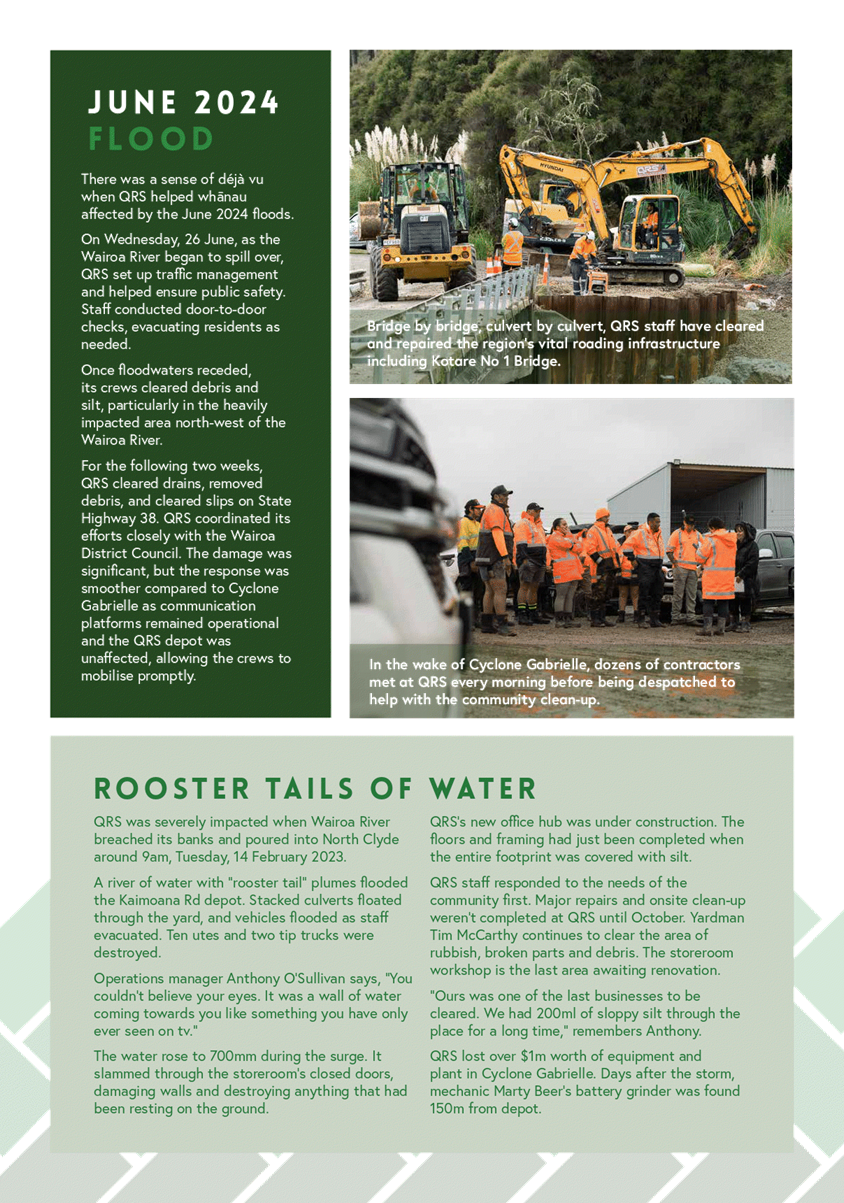
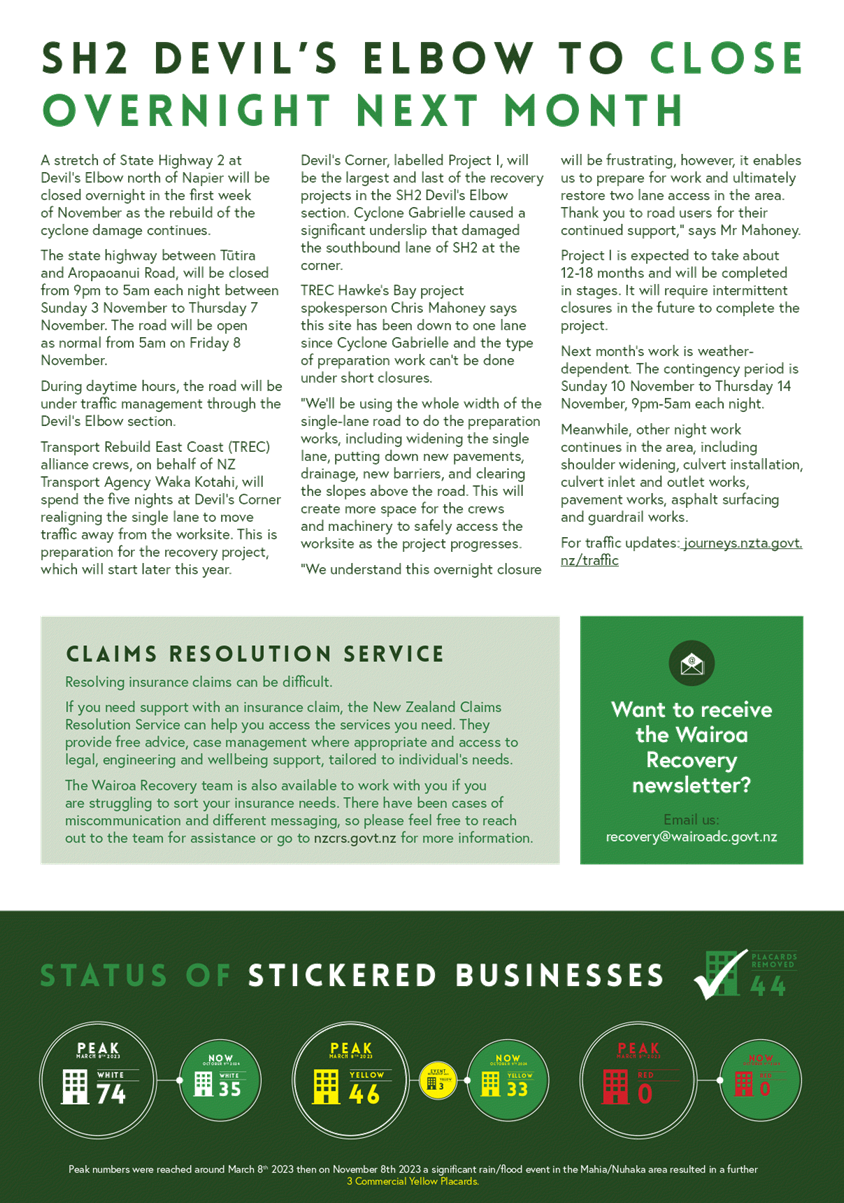


HB
CDEM Group Joint Committee
25
November 2024
Subject: HB Regional Recovery Agency
update
Reason for report
1. This report provides an
update on recovery from Cyclone Gabrielle.
Context
2. In February 2023, Cyclone
Gabrielle inflicted significant loss and damage to the Hawke’s Bay region
along with other parts of the country: tragic loss of lives and livelihoods,
displacement of whānau, and damage to the economy, infrastructure,
businesses, homes and the environment. Hawke’s Bay faced a major recovery
effort following the event.
3. In line with national
guidelines, the approach taken to Cyclone Gabrielle Recovery is “Locally
led, Regionally coordinated, Nationally supported”. Within that
context, organisations across the region are engaged in recovery activities in
the wake of Cyclone Gabrielle 14 February 2023.
4. The region, through the
Matariki Governance Group (MGG), established the Hawke’s Bay Regional
Recovery Agency (RRA) to coordinate recovery efforts across the region and with
Government. While the RRA reports to an Oversight Board and MGG to ensure wide
regional engagement, recovery activity also falls within the purview of the HB
CDEM Group Joint Committee as part of the broader CDEM framework.
5. It is noted that members of
the Joint Committee also sit on the MGG.
Update
6. The RRA continues to work
with the Matariki partner organisations, and Government and its agencies to:
6.1. support partner agency
recovery actions
6.2. coordinate recovery work
across organisations and between the region and government
6.3. plan next stage recovery
activity and assist with thought leadership on recovery and resilience, and
6.4. advocate to Government and
its agencies for financial and other assistance with recovery efforts.
7. This work includes both
immediate and short-term recovery priorities as well as longer-term recovery
and resilience priorities and opportunities, including those captured in the
regional ‘Briefing to Incoming Ministers’ (BIM) and Te Matau-a-Māui
Hawke’s Bay Recovery Plan 2.0.
8. Good progress has been made
on the delivery of a number of programme actions by agencies involved in the
recovery and/or the RRA. Funding has been secured for both components of the
Waipawa drinking water (with stopbank reinstatement completed), and for additional
resourcing to speed up delivery of Crown-funded recovery projects.
Orders-in-Council have been secured for both flood protection works and
on-farm/forest rural recovery works, securing vital regulatory process relief.
Work continues on other short-term priorities as reported below, including
significant work under the Kaupapa Māori pathway for FoSAL land
categorisation areas. Notable progress has seen Petane Marae agreeing terms
with the Crown for funding for the relocation and rebuild of the marae. The
silt and debris clearance programme is also making good progress and nearing
conclusion.
9. Significant focus has also
been applied to achieving progress across a range of medium to longer-term
priorities. Areas of focus have included local road recovery works funding,
development of a water security vision paper, development of proposals for regional
housing resilience initiatives, engagement on the Regional Infrastructure Fund
process and support for the related Ministerial roadshow, and programme support
for the North Island Weather Events (NIWE) Crown Funding Agreement
implementation.
10. Good progress has been made
in respect of funding for local road recovery works. Advocacy work by the
Mayors, Regional Council Chair and Regional Transport Committee Chair,
supported by the RRA, has led to confirmation that the $91 million allocated to
Hawke’s Bay following Budget 24 was all available in this financial year.
Work programmes and funding allocations have subsequently been confirmed, and
the NZTA Board has approved additional bespoke funding arrangements (FAR +30%)
for the 2024/25 financial year. This represents a good outcome for the advocacy
work undertaken.
11. Work is underway in
developing a multi-year funding programme as invited by the Minister of
Transport.
12. In terms of state highway
funding, funding for design, consenting, property acquisition and initial
construction works on the preferred full Waikare Gorge realignment project is
now included in the National Land Transport Programme. This is positive news
for Wairoa, northern Hawke’s Bay and beyond. This follows strong support
from the region’s civic leaders for leaving the temporary bailey bridge
in place longer to enable the full Waikare realignment project to occur in the
foreseeable future.
13. The work programme
associated with the NIWE (2023) Hawke’s Bay Crown Funding Agreement is
being implemented. The programmes funded under the agreement are the FoSAL
category 3 voluntary property buyout programme (Hastings District Council and
Napier City Council), the category 2 flood protection programme of works
(Hawke’s Bay Regional Council and Hastings District Council), and a
specified transport programme of works (Hastings District Council, Wairoa
District Council and Central Hawke’s Bay District Council).
14. The voluntary buyout
programme is very well advanced. Only four offers remain to be made which are
owner and insurance dependent. Required demolition will be complete by year end
and the Voluntary Buyout Office will close. This Hastings and Napier led programme
has been a highly competent and successful recovery programme.
15. NIWE transport programmes
are also progressing relatively well. Hastings District Council (who at $228
million has the bulk of the transport funding under the Crown funding
agreement) has made significant progress. Following on from the opening of the
crystal culvert in Tūtira in July, construction work is in progress on a
range of other projects. These include:
15.1. Matapiro bridge –
tender awarded, construction activity commenced, completion scheduled mid-2025
15.2. Taihape road slip repairs
– 11 slip sites, physical works commenced 19 August, 18-month timeframe
for completion
15.3. Dartmoor slip –
construction commenced February 2024, construction in progress, completion
expected by Christmas 2024
15.4. Puketapu bridge –
abutment piling complete, construction in progress, completion scheduled
mid-2025
15.5. Kereru Gorge culvert
–construction in progress
15.6. Rissington bridge –
option assessment and iwi engagement underway, construction start scheduled for
mid-2025, construction period circa 12 months.
16. Central Hawke’s Bay
has four Crown funded repair projects: Fletchers Crossing Bridge, Elsthorpe
Road slip and two slips on Wimbledon Road. Construction for these is scheduled
for the 2024-25 construction season.
17. Wairoa District Council has
one project: replacement of Te Reinga Bridge. Preliminary design work has been
completed based on a network arch design. Procurement work has commenced,
seeking to utilise early contractor engagement. Resource and building consent
applications have been prepared and land access discussions are underway.
18. HBRC is advancing the flood
protection work programme to enable households in category 2 areas to move to
category 1. Four project delivery plans have been signed off by ministers, with
a number of others imminent. Design work, programme planning, land access and
programme delivery continues across the range of projects. A ‘sod
turning’ for the Waiohiki project was held on 11 November 2024. The
Wairoa flood protection project is under the oversight and direction of the
appointed Crown manager. Two design options are currently the subject of
community consultation and landowner/stakeholder engagement.
19. Budget 24 contained $20m
for 2023 NIWE councils to access to help speed up delivery of existing, funded,
recovery projects. HBRC, HDC, CHBDC and Wairoa DC were all successful with
funding requests. This funding will help deliver recovery projects faster.
20. As part of the recovery
programme and in line with Recovery Plan 2.0 approved by Matariki Governance
Group, resilience work is being undertaken in a number of areas. These include
water security and housing resilience. Progressive procurement and workforce
development work is also being done to support broader social outcomes from
recovery work programmes.
21. The RRA produces recovery
dashboard highlighting progress in key areas of recovery activity. The latest
dashboard (October) is attached. It is hoped that an updated dashboard
will be available prior to the meeting.
Decision-making considerations
22. Staff have assessed the
requirements of the Local Government Act 2002 in relation to this item and have
concluded that, as this report is for information only, the decision-making
provisions do not apply.
Recommendation
That
the HB Civil
Defence Emergency Group Joint Committee receives and notes the HB Regional
Recovery Agency update report.
Authored by:
|
Ross McLeod
Chief Executive, HB Regional
Recovery Agency
|
|
Approved by:
|
Shane Briggs
HB CDEM Acting Group Manager /
Controller
|
|
Attachment/s
|
1⇩
|
Hawke's Bay Regional Recovery
Dashboard
|
|
|
|
Hawke's Bay Regional Recovery Dashboard
|
Attachment
1
|
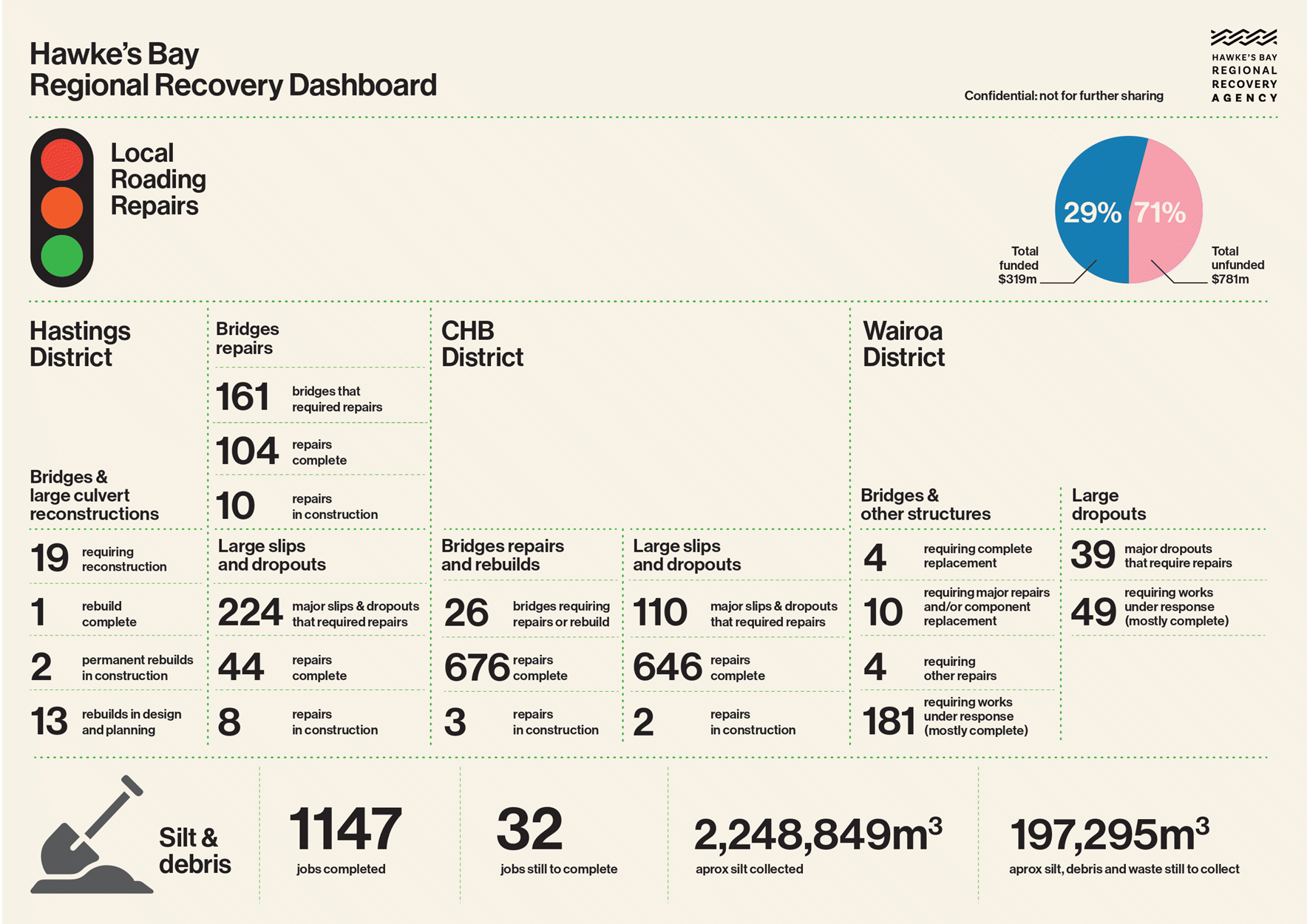
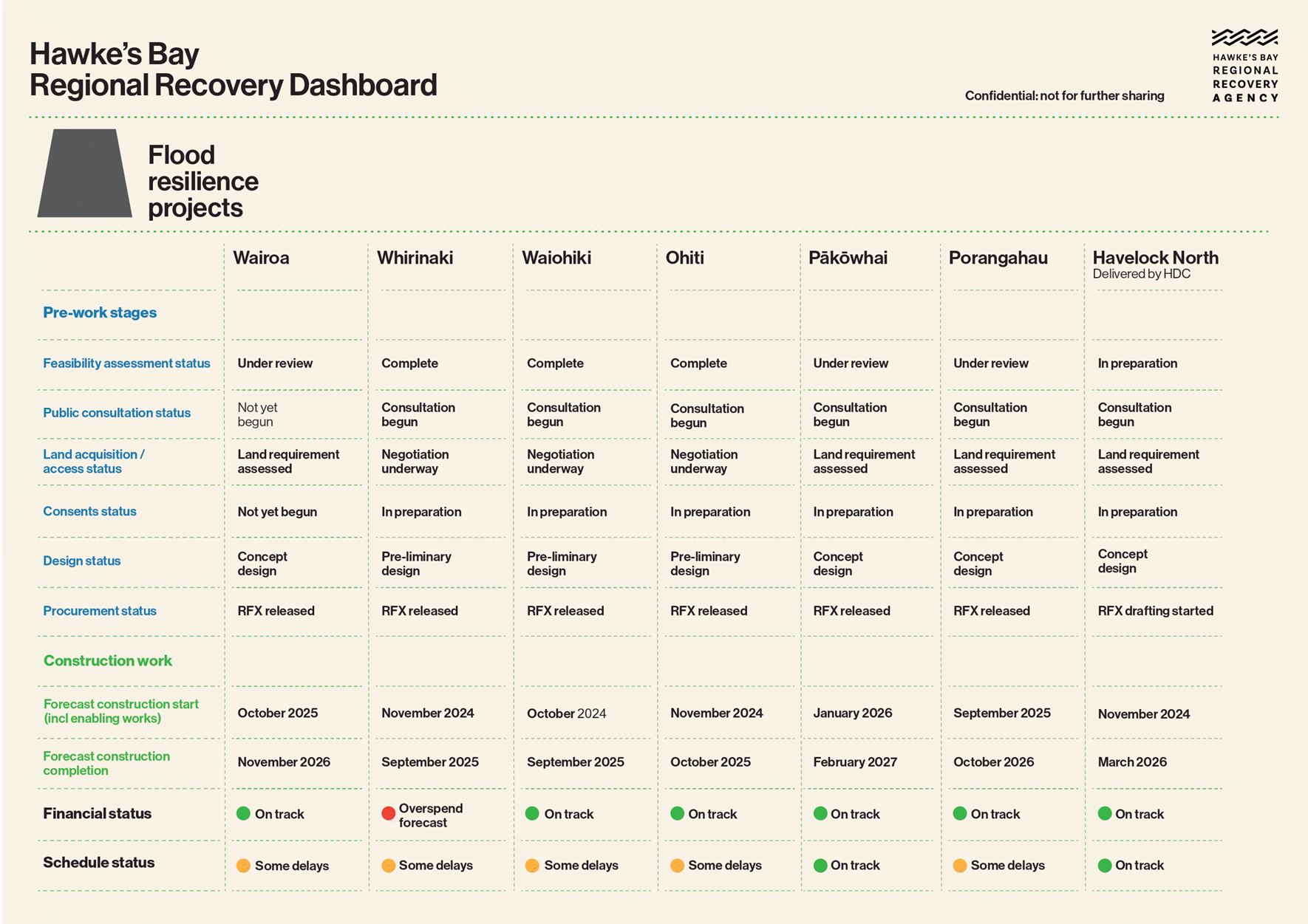
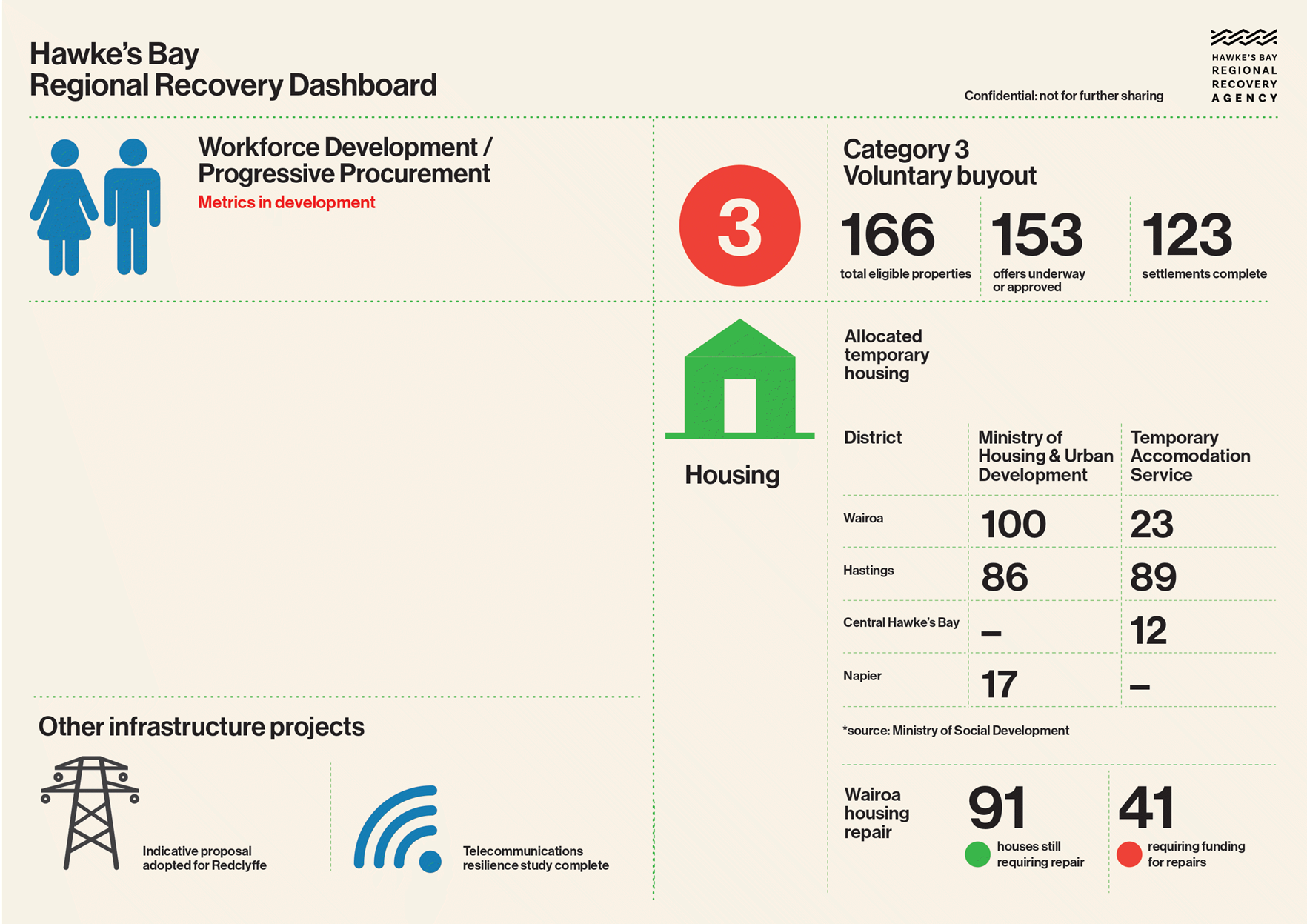
HB
CDEM Group Joint Committee
25
November 2024
Subject: HB CDEM Group Transformation
update
Reason for report
1. This item gives the Joint
Committee an update on the HB CDEM Group Transformation programme.
Background
2. The HB CDEM Joint Committee
commissioned a review of the response of HB CDEM Group response to Cyclone
Gabrielle.
3. The review identified
critical shortcomings in the ability of HB CDEM to respond to large scale
events.
4. The review made a series of
significant recommendations. The recommendations range from empowering
communities, to integrating mana whenua into HB CDEM at all levels, to the
structure and function from the Group office, the local role of individual
councils and disaster scenario planning.
5. As a result, a HBCDEM
Transformation Director was employed in August 2024 on a fixed term contract
with the following mandate:
5.1. Produce a clear prioritised
action plan to transform the HB CDEM system so that HB CDEM is fit for purpose
to deliver on the 4 Rs.
5.2. Lead implementation of the
action plan including but not limited to:
5.2.1. establish clarity of
functions and accountabilities for key players in the HB CDEM Group
5.2.2. identify the structure of
HB CDEM Group to deliver on key functions and accountabilities across the
spectrum from communities at place, through individual councils, to the Group
Office
5.2.3. work with tangata whenua
leaders to integrate mana whenua and mātauranga at all levels in HB CDEM
5.2.4. identify the critical
components of a new HB CDEM Group plans and local plans
5.2.5. identify key risks and
mitigations for response to a major event should it occur during the
transformation of HB CDEM
5.2.6. provide recommendations on
longer term approaches to the 4 Rs
5.2.7. take a leading role in
project teams and steering groups
5.2.8. provide leadership and
advice during the implementation phase of different change processes
5.2.9. identify and evaluate
initiatives to ensure projects meet the required goals
5.2.10. Influence both culture and
behaviour changes in the HB CDEM system.
Discussion
6. The HB CDEM Transformation
approach is detailed below.
7. A HB CDEM Transformation
Strategy has been produced, currently in DRAFT, and aims to provide Governance
and Elected members with a vision, set of guiding transformation principles and
approach to updates to enable programme performance measurement.
8. A HB CDEM Transformation
Plan has been produced, currently in DRAFT, and aims to provide Council
Executives with operational detail and coordination to enable transformation
management to occur.
9. It is envisaged that a HB
CDEM Supplementary Transformation Plan will be produced in 2025 that will
provide the outline detail required to develop appropriate capital investment
business cases for HBCDEM assets and infrastructure.
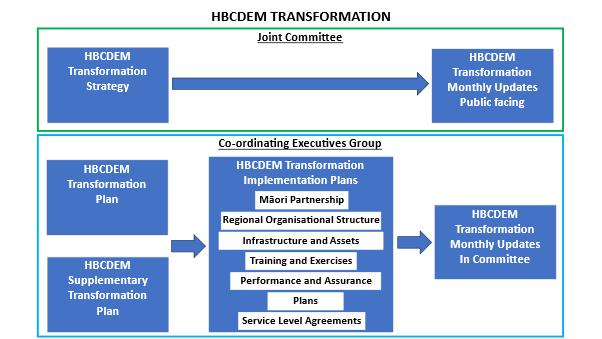
10. Progress is being made on
the seven HB CDEM Transformation implementation plans with further detail
provided in early 2025.
11. Of note is the intent to
conduct, in 2025, a range of training activities and exercises culminating in a
major Hawkes Bay wide emergency management exercise.
12. Each Council should be
prepared to make staff available for individual training courses in the first
half of 2025.
13. Each Council should be
prepared for a series of emergency management exercises to occur in 2025.
14. The Joint Committee should
note that engagement with mana whenua is a major component of the HB CDEM
Transformation. The current HB CDEM Transformation Plan exist in DRAFT
deliberately to enable sincere and meaningful mana whenua engagement to occur
in 2025 and beyond.
15. The Joint Committee should
note that as identified there is risk to local and regional emergency
management BAU and response over the transformation period.
16. The HB CDEM Transformation
initiative will progress through the next steps before the end of 2024:
16.1. Workshop the DRAFT HB CDEM
Transformation Strategy with the Joint Committee.
16.2. Engage on the DRAFT HB CDEM
Transformation Strategy with TKO, the HB CDEM Group, local councils and
Coordinating Executives Group members.
16.3. Re-draft the HB CDEM
Transformation Strategy and gain Joint Committee approval, ideally in an
extraordinary meeting prior to years end (2024).
17. The first of the HB CDEM
Transformation updates will be available in February 2025.
18. The HB CDEM Transformation
initiative is considered on track and progressing well with no major unexpected
issues encountered.
Decision-making considerations
19. Staff have assessed the
requirements of the Local Government Act 2002 in relation to this item and have
concluded that, as this report is for information only, the decision making
provisions do not apply.
Recommendation
That
the HB CDEM
Group Joint Committee receives and notes the HB CDEM Group Transformation
update staff report.
Authored & Approved by:
|
Matt Boggs
Director HB CDEM Transformation
|
|
Attachment/s
There are no attachments for this
report.
HB
CDEM Group Joint Committee
25
November 2024
Subject: Confirmation of HB CDEM Group Joint
Committee 29 July 2024 Public Excluded Minutes
That the HB
Civil Defence Emergency Management Group Joint Committee excludes the public
from this section of the meeting being Confirmation of Public Excluded Minutes
Agenda Item 7 with the general subject of the item to be considered
while the public is excluded. The reasons for passing the resolution and the
specific grounds under Section 48 (1) of the Local Government Official
Information and Meetings Act 1987 for the passing of this resolution are:
|
General
subject of the item to be considered
|
Reason
for passing this resolution
|
Grounds
under section 48(1) for the passing of the resolution
|
|
Amendments to the
Hawke's Bay CDEM Group Plan: Controller and Recovery Manager appointments
|
In considering the
candidates for Controller the names, experience and qualifications will be made
available which, if made public would breach the privacy of the individuals
concerned.
|
s7(2)(a) Excluding the
public is necessary to protect the privacy of natural persons
|
Authored by:
|
Leeanne Hooper
Team Leader Governance
|
|
Approved by:
|
Desiree Cull
Strategy & Governance Manager
|
|
HB
CDEM Group Joint Committee
25
November 2024
Subject: Local Controller Appointments
That the HB
CDEM Group Joint Committee excludes the public from this section of the
meeting, being Agenda Item 10 Local Controller Appointmentswith the
general subject of the item to be considered while the public is excluded. The
reasons for passing the resolution and the specific grounds under Section 48
(1) of the Local Government Official Information and Meetings Act 1987 for the
passing of this resolution are:
|
General
subject of the item to be considered
|
Reason
for passing this resolution
|
Grounds
under section 48(1) for the passing of the resolution
|
|
Local Controller
Appointments
|
In considering the
candidates for Controller the names, experience and qualifications will be
made available which, if made public would breach the privacy of the
individuals concerned.
|
s7(2)(a) Excluding the public is necessary to protect the
privacy of natural persons.
s7(2)(f)(ii) Excluding
the public is necessary to maintain the effective conduct of public affairs
by protecting councillors and/or council employees and contractors/
consultants from improper pressure or harassment.
|
Authored & Approved by:
|
Shane Briggs
HB CDEM Acting Group Manager /
Controller
|
|







































